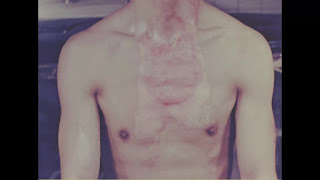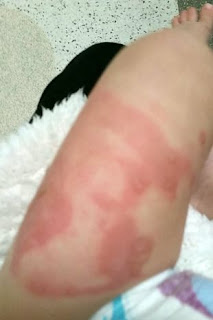Electrocution Death: Introduction, Cause and Postmortem Findings
(A) Death due to Electricity
When an electric current passed through a human body, it produces localized muscular spasms, tiny marks, and even death with little or no apparent burns.
Factors affecting injuries by electric current
1. Kind of current
Alternating current (AC) is around 5 times more risky than direct current (DC). AC causes tetany stimulation and doesn't let the person lose the grip of the electric source until the power gets off whereas DC tends to cause single muscle contraction, throwing the victim and resulting in blunt injuries.
2. Amount of Current
The flow of current is directly proportional to the voltage applied to it (V=IR). Electrocution is rare at less than 100 V and most death occur at greater than 200 V.
3. Path of Current
Death is more likely to occur if the brainstem or heart is in the direct path of the current.
4. Duration of current flow
The severity of injuries is directly proportional to the duration of the current flow. For an electric shock to happen, the body must be in contact with both positive and negative poles or with the earth.
5. Resistance
The greater the resistance, the more likely that burns will occur. For example, dry skin offers high resistance (1000-1500 ohm), but resistance is decreased when the skin is moist or covered with sweat (200-300 ohm) resulting in test injuries.
6. Site of contact
Electrical injuries occurred on the face and arms are more harmful than those on the palms.
Effects on the body due to the passage of electricity
1. Burns (Joule Burns) and blisters
Joule burns are specific and found at the point of entry. These are round or oval or irregular, chalky white shallow centrally collapsed blisters. They are 1-1.5 cm in diameter and have raised borders of about 1-2 mm round.
When in prolonged contact, the skin on the mark may become brown and width further duration of contact, charring may occur. When the current stops, the blisters cool and collapse to leave a crater with raised rim.
2. Exit marks
Exit marks are variable in appearance but have some features of the entrance wound. There may be more damage to the tissues and often splits are seen at points where the skin has been raised as ridges due to the passage of the current.
3. Flash or spark burns
Flash/spark burn occurs where the contact is less firm and an air gap exists between the skin and the conductor and the current jumps the gap as a spark and causes the outer skin keratin to melt over a small area. Finally, on cooling, the keratin fuses into a hard brownish nodule, usually raised above the surrounding surface.
4. Splits Burns
They occur when the electric conductor is a wire which produces a linear burn. A bright green imprint may be seen if the conductor is made up of copper and brass. The splits are dry, hard, hard, firm, charred, and insensitive with ragged edges with a round or oval or linear or irregular shape.
Postmortem Findings of Electrocution Death
1. External Findings
Examination of the entire body like hands, fingers, feet, etc is done to find any electrical burns. The face seems to be pale, eyes are congested and pupils are dilated. Petechiae is seen on eyelids. Rigor mortis appears early and dark blue and red postmortem staining is seen. Joule burn is seen at the site of entry.
2. Internal Findings
Lungs are congested and edematous. The heart shows focal necrosis with variable hemorrhage. The brain is congested and shows meninges. Petechial hemorrhages may be found along the line of passage of the current.
Cause of death in electrocution
- If the current pass through any of the limbs to the head then death is probably due to the paralysis of the respiratory center.
- If the circuit passes through the arm to the arm which involves the heart then death is due to cardiac arrest.
- If the contact time is more but the current is slow, then death occurs due to muscle paralysis and secondary asphyxia.
- If the current is high voltage then death occurs due to respiratory arrest.
- Sometimes the victim may suffer from loss of sight, hearing, or memory impairment.
- Death may also occur due to hemorrhage due to rupture of the blood vessels.
Circumstances of Electrocution
1. Accidental electrocution
The majority of electrocution death occurs due to accidental electrocution with contact with low voltage currents (220-240 volts). Accidents may occur due to faulty lines, cooking heaters, room heaters, electric coils, etc. Accidents due to contact with high-voltage supplies are usually seen in industries.
2. Suicidal electrocution
This is rare but can happen. In suicidal electrocution, the victim usually winds wire around the wrist and other parts of the body and makes their connection with the wall, and switches it on.
3. Homicidal electrocution
In homicidal electrocution, a person tries to kill another through means of electric current.
4. Iatrogenic electrocution
In Iatrogenic electrocution, death may occur while the treatment of patients with electrical equipment.
5. Judicial electrocution
Judicial electrocution was first carried out in the USA in mid 19th century. In this, the condemned man is strapped on a wooden chair and one cap-like electrode is put on the shaven head scalp and then a voltage of 200 volts and 7-ampere current is passed for one minute. The same process is repeated the second time till the victim dies.
B) Death due to Lightning
A lightning bolt (DC<1000 million V) is produced when the charged undersurface of a thundercloud sends its electrical charge to the ground. It may instantaneously kill a person through a direct strike, side flash, or conduction through another object.
Lichtenberg flower marking may be seen on the victim. These are superficial, several inches long, then irregular red marks on the skin. Death by lightning comes under accidental electrocution.
Development of edema on the skin is seen. Linear-like contusions, lacerations, rupture of the tympanic membrane, and spinal cord damage.






